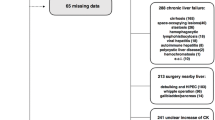Abstract
Purpose
Hypoxic hepatitis may be induced by hemodynamic instability or arterial hypoxemia in critically ill patients. We investigated the incidence, etiology, association with systemic ischemic injury and risk factors for mortality in this population.
Methods
Retrospective analysis of patients with hypoxic hepatitis admitted to a multidisciplinary intensive care unit (ICU) of a university hospital. Hypoxic hepatitis was defined as the existence of a compatible clinical setting (cardiocirculatory failure or arterial hypoxemia) and aminotransferase levels higher than 1000 IU/L.
Results
During the 8-year study period, 182 out of the 7674 patients admitted presented hypoxic hepatitis (2.4%). The most common cause was septic shock. The rate of in-hospital mortality in hypoxic hepatitis was 61.5% (112 patients), and was higher in patients with septic shock (83.3%) and cardiac arrest (77.7%). Ischemic pancreatitis (25.6%), rhabdomyolysis (41.2%) and renal failure (67.2%) were common in these patients. Risk factors of mortality were prolonged INR (p = 0.005), need for renal replacement therapy (p = 0.001) and septic shock (p = 0.005).
Conclusions
Hypoxic hepatitis was not a rare condition, and was frequently accompanied by multiorgan injury, with high mortality. Risk factors for increased mortality were prolonged INR, need for renal replacement therapy, and septic shock.


Similar content being viewed by others
References
Fuchs S, Bogomolski-Yahalom V, Paltiel O, Ackerman Z. Ischemic hepatitis: clinical and laboratory observations of 34 patients. J Clin Gastroenterol. 1998;26:183–6.
Henrion J, Schapira M, Luwaert R, Colin L, Delannoy A, Heller FR. Hypoxic hepatitis: clinical and hemodynamic study in 142 consecutive cases. Medicine (Baltimore). 2003;82:392–406.
Birrer R, Takuda Y, Takara T. Hypoxic hepatopathy: pathophysiology and prognosis. Intern Med. 2007;46:1063–70.
Fuhrmann V, Kneidinger N, Herkner H, Heinz G, Nikfardjam M, Bojic A, Schellongowski P, Angermayr B, Kitzberger R, Warszawska J, Holzinger U, Schenk P, Madl C. Hypoxic hepatitis: underlying conditions and risk factors for mortality in critically ill patients. Intensive Care Med. 2009;35:1397–405.
Whitehead MW, Hawkes ND, Hainsworth I, Kingham JG. A prospective study of the causes of notably raised aspartate aminotransferase of liver origin. Gut. 1999;45:129–33.
Henrion J, Minette P, Colin L, Schapira M, Delannoy A, Heller FR. Hypoxic hepatitis caused by acute exacerbation of chronic respiratory failure: a case-controlled, hemodynamic study of 17 consecutive cases. Hepatology. 1999;29:427–33.
Henrion J, Descamps O, Luwaert R, Schapira M, Parfonry A, Heller F. Hypoxic hepatitis in patients with cardiac failure: incidence in a coronary care unit and measurement of hepatic blood flow. J Hepatol. 1994;21:696–703.
Raurich JM, Perez O, Llompart-Pou JA, Ibáñez J, Ayestarán I, Pérez-Bárcena J. Incidence and outcome of ischemic hepatitis complicating septic shock. Hepatol Res. 2009;39:700–5.
Nathwani RA, Pais S, Reynolds TB, Kaplowitz N. Serum alanine aminotransferase in skeletal muscle diseases. Hepatology 2005;41:380–2.
Melli G, Chaudhry V, Cornblath DR. Rhabdomyolysis: an evaluation of 475 hospitalized patients. Medicine (Baltimore). 2005;84:377–85.
Blanco JR, Zabalza M, Salcedo J, Echeverria L, García A, Vallejo M. Rhabdomyolysis of infectious and noninfectious causes. South Med J. 2002;95:542–4.
Yadav D, Agarwal N, Pitchumoni CS. A critical evaluation of laboratory tests in acute pancreatitis. Am J Gastroenterol. 2002;97:1309–18.
Perez A, Ito H, Farivar RS, Cohn LH, Byrne JG, Rawn JD, Aranki SF, Zinner MJ, Tilney NL, Brooks DC, Ashley SW, Banks PA, Whang EE. Risk factors and outcomes of pancreatitis after open heart surgery. Am J Surg. 2005;190:401–5.
Levy EM, Viscoli CM, Horwitz RI. The effect of acute renal failure on mortality. A cohort analysis. JAMA. 1996;275:1489–94.
Liano F, Pascual J. Epidemiology of acute renal failure: a prospective, multicenter, community-based study. Madrid Acute Renal Failure Study Group. Kidney Int. 1996;50:811–8.
Paganini EP, Halstenberg WK, Goormastic M. Risk modeling in acute renal failure requiring dialysis: the introduction of a new model. Clin Nephrol. 1996;46:206–11.
Levy MM, Fink MP, Marshall JC, Abraham E, Angus D, Cook D, Cohen J, Opal SM, Vincent JL, Ramsay G: 2001 SCCM/ESICM/ACCP/ATS/SIS International Sepsis Definitions Conference. Crit Care Med. 2003;31:1250–56.
Manji RA, Wood KE, Kumar A. The history and evolution of circulatory shock. Crit Care Clin. 2009;25:1–29 (vii).
Task Force for Diagnosis and Treatment of Acute and Chronic Heart Failure 2008 of European Society of Cardiology, Dickstein K, Cohen-Solal A, Filippatos G, McMurray JJ, Ponikowski P, Poole-Wilson PA, Strömberg A, van Veldhuisen DJ, Atar D, Hoes AW, Keren A, Mebazaa A, Nieminen M, Priori SG, Swedberg K; ESC Committee for Practice Guidelines, Vahanian A, Camm J, De Caterina R, Dean V, Dickstein K, Filippatos G, Funck-Brentano C, Hellemans I, Kristensen SD, McGregor K, Sechtem U, Silber S, Tendera M, Widimsky P, Zamorano JL. ESC guidelines for the diagnosis and treatment of acute and chronic heart failure 2008: the Task Force for the Diagnosis and Treatment of Acute and Chronic Heart Failure 2008 of the European Society of Cardiology. Developed in collaboration with the Heart Failure Association of the ESC (HFA) and endorsed by the European Society of Intensive Care Medicine (ESICM). Eur Heart J. 2008;29:2388–442.
Le Gall JR, Lemeshow S, Saulnier F. A new Simplified Acute Physiology Score (SAPS II) based on a European/North American multicenter study. JAMA. 1993;270:2957–63.
Seeto RK, Fenn B, Rockey DC. Ischemic hepatitis: clinical presentation and pathogenesis. Am J Med. 2000;109:109–13.
Ceppa EP, Fuh KC, Bulkley GB. Mesenteric hemodynamic response to circulatory shock. Curr Opin Crit Care. 2003;9:127–32.
Malinoski DJ, Hadjizacharia P, Salim A, Kim H, Dolich MO, Cinat M, Barrios C, Lekawa ME, Hoyt DB. Elevated serum pancreatic enzyme levels after hemorrhagic shock predict organ failure and death. J Trauma. 2009;67:445–9.
DeJonghe B, Cheval C, Misset B, Timsit JF, Garrouste M, Montuclard L, Carlet J. Relationship between blood lactate and early hepatic dysfunction in acute circulatory failure. J Crit Care. 1999;14:7–11.
Bansal V, Schubert VD. Jaundice in the intensive care unit. Surg Clin North Am. 2006;86:1495–502.
Conflict of interest
All authors declare no conflict of interest.
Author information
Authors and Affiliations
Corresponding author
About this article
Cite this article
Raurich, J.M., Llompart-Pou, J.A., Ferreruela, M. et al. Hypoxic hepatitis in critically ill patients: incidence, etiology and risk factors for mortality. J Anesth 25, 50–56 (2011). https://doi.org/10.1007/s00540-010-1058-3
Received:
Accepted:
Published:
Issue Date:
DOI: https://doi.org/10.1007/s00540-010-1058-3




